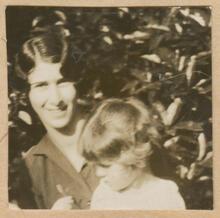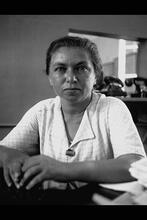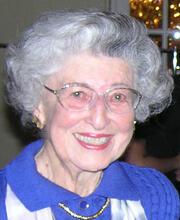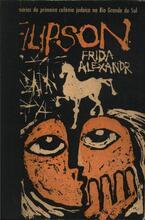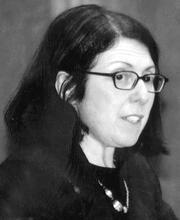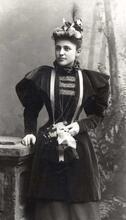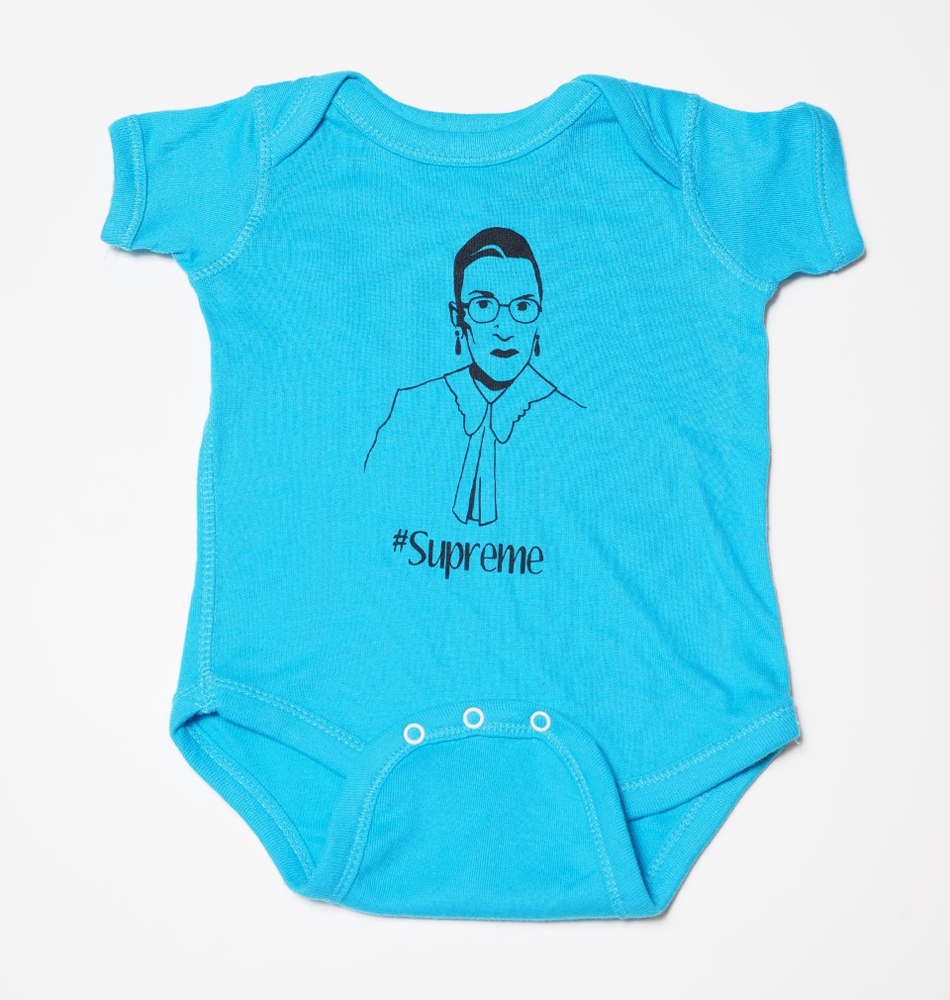Lillian Simon Freehof
While fulfilling impeccably all the roles expected of the wife of a prominent Reform rabbi in the twentieth century, Lillian Simon Freehof also fulfilled the yearnings of her own life as an individual, by pursuing her education, building a career as a writer of books for children and young adults, and leading the women of her congregation and of the National Federation of Temple Sisterhoods (now WRJ) in developing Braille transcription services for adults with blindness and visual impairments.
Early Life and Marriage
Lillian Simon Freehof, who was born on August 12, 1906, was the second child of Morris W. and Flora Rubenstein Simon; her siblings were Robert R., Charles H., and Leonard S. Simon. She was raised in a suburb of Chicago, where her father was employed as a printer. She attended the University of Chicago and the University of Wisconsin, studying English literature, political science, philosophy, and languages, before taking a job as the secretary to Rabbi Solomon B. Freehof of KAM Temple (now KAM Isaiah Israel), the oldest Jewish congregation in Chicago. When Solomon Freehof was named Rabbi of Rodef Shalom Congregation in Pittsburgh, Pennsylvania, in 1934, Lillian followed, and the two were married soon afterwards.
Despite a certain ambivalence toward the expectations the community had for a rabbi’s wife, Freehof overcame her natural shyness to take on this public role, supporting Rabbi Freehof in his positions as pulpit rabbi, prominent scholar of Jewish law, and leader of national and international Reform Jewish organizations. She was his first reader, typist, editor, proofreader, and business manager for most of the books he published about the Bible, theology, popular literature, and Jewish law. At the same time, she developed other roles that arose from her own interests and talents. In 1936, she completed her bachelor’s degree at the University of Pittsburgh, taking courses in psychology, philosophy, and English. A decade later, she took courses in short-story and fiction writing, also at the University of Pittsburgh. Her husband encouraged her to write, and she began with one-act plays suitable for the TemPlayers, the Sisterhood drama group she started at Rodef Shalom.
Writing for Children
Moving on to children’s literature, Freehof re-wrote Bible stories and legends in language suitable for elementary school readers, beginning in 1948 with The Bible Legend Book. Later, taking the Pirkei Avot as her foundation, she wrote The Right Way (1955), an ethics textbook for high-school students that was used widely in religious schools for many years. Her goal for that book was to modernize the Jewish ethical texts to appeal to teenagers, and, near the end of her life, she intended to update the book for another generation of students. She wrote more than twenty books for young audiences, including plays, mysteries, and holiday stories. Though childless herself, Freehof said that “in writing for children, we write for the remembered child in us.”
In 1953, Lillian Freehof won the National Jewish Book Award for Children's Literature for Stories of King David and Star Light Stories. She used her writing for young people as a vehicle for expressing her Jewish values; about her book, The Savage (1960), which treats dual themes of disability and what was then called “juvenile delinquency,” she wrote, “Knowing how much injustice has been done to people who are born with blindness or some other physical or mental abnormality . . . I wanted young people to learn that these people need the opportunity to live normal lives.”
Braille Transcription
Freehof became interested in Braille because she had a cousin who lived with blindness, and at Rodef Shalom she worked with the Sisterhood to revitalize the work it had begun in the 1920s to provide services for the blind. She became certified by the American Red Cross as a Braille teacher and later by the Library of Congress as a Braille transcriber, and, beginning in 1938, she taught that skill in a long succession of transcription classes that were open to the whole community. After taking Freehof’s course and completing practice transcription assignments, dozens of her students also attained their Library of Congress certifications. Rodef Shalom Sisterhood invested in reams of Braille paper and a fleet of Braillewriters, which transcriptionists could take home to complete their book assignments. For women with young children at home, the work provided a self-paced, calm, and structured break from the pace of their active days.
From the late 1930s through the 1980s, the Sisterhood Braille program, using only volunteer labor, produced and bound hundreds of Braille and large-print books for readers with low vision and blindness all over the country. The program was discontinued when technological innovations such as “talking books” and, more recently, computer adaptations for individuals with visual impairments lessened the need for the bulky Braille books. Thanks largely to Freehof’s efforts, Braille transcription was adopted as a project by the National Federation of Temple Sisterhoods, which she served as a national board member from 1958 to1962 and as chair of the Committee on Service to the Blind in the early 1960s. The Rodef Shalom Sisterhood Committee on Service to the Blind collaborated with major national organizations serving people with blindness, such as the Library of Congress and the Jewish Braille Institute, as well as with local organizations, primarily the nearby Western Pennsylvania School for Blind Children, and with schools, universities, and individuals.
The committee’s goal was to increase the accessibility of written resources for individuals with visual impairments by transcribing the books that were actually requested by such individuals for their educational, work-related, and leisure activities. While it maintained a special focus on Jewish materials, giving top priority to requests from Jewish individuals and Jewish organizations that provided services to persons with visual impairments, in practice it fulfilled nearly every transcription request it received. These included a wide variety of reading materials, from sex education brochures for Planned Parenthood, to textbooks for a Presbyterian minister who was a graduate student in urban planning, to a Singer sewing machine manual for a visually impaired seamstress. Over the years, the committee completed books in English, Hebrew, and several European languages; one volunteer learned how to transcribe in the Hausa language of Nigeria in order to be able to fulfill a special request from a graduate student.
At first under Lillian Freehof’s supervision, and later, as the program grew, with additional Rodef Shalom volunteers in active leadership, the Sisterhood Braillers produced an average of more than 10,000 pages of Braille transcriptions per year. Freehof had the pleasure of transcribing all of the scholarly books written by her husband, and Sisterhood volunteers in turn transcribed Lillian’s books. As a Sisterhood fundraising project and also a much-needed service for visually impaired cooks, Freehof co-authored, with Esther Simon Tyrnauer, Little Recipes in Big Type, in 1973.
Crafts and Decorative Arts
Freehof’s interest in crafts and the decorative arts led her to co-author Flowers and Festivals of the Jewish Year with Lottie C. Bandman, in 1964, and Embroideries and Fabrics for Synagogue and Home: 5000 Years of Ornamental Needlework with Bucky King, in 1966. An accomplished crocheter herself, Freehof encouraged Rodef Shalom volunteers to produce hand-crafted items needed during World War II. Until the end of her life, she remained an active participant in the Sisterhood sewing group, creating decorative items including hand-stitched challah covers and baby items to stock the Sisterhood Gift Corner, as well as a Torah cover she made for the congregation to honor her husband’s fifty years in the rabbinate. She also played the piano and recorder and was a supporter of fine arts and theater organizations in Pittsburgh.
Community Service
Lillian S. Freehof contributed to the Pittsburgh community in many ways, serving on the boards of the Pittsburgh Playhouse, the United Jewish Federation of Pittsburgh, the Gusky Orphanage, Pittsburgh Child Guidance, the Jewish Social Service Bureau, and the Brandeis University National Women’s Committee, Pittsburgh Chapter. Though she contributed to the work of many community organizations, it was her firm policy never to take on the presidency of any of them, so as to let others develop their leadership gifts. In 1976, Israel Bonds honored her with the Eleanor Roosevelt Humanities Award. Freehof lent a stylish and elegant presence to many social occasions, often wearing one of her stunning hats. She was a good cook with a gift for hospitality and for making others feel welcome. Never one to take center stage, she nevertheless exerted her own quiet kind of leadership in her many activities.
Later Life
In her oral history, Freehof said that being the wife of Rabbi Freehof was the most important experience of her life, and she supported him in the ways expected of a rabbi’s wife at that time. The Freehofs traveled widely, both in connection with his professional activities and on regular vacations to Maine and California. When they toured Europe and Israel together in 1953, the Pittsburgh Sun-Telegraph newspaper published their dispatches from various cities, and these were later reproduced in a published booklet. Throughout their long life together, Lillian kept large scrapbooks of photographs and news clippings documenting Rabbi Freehof’s activities during his long rabbinic career. After her husband died in 1990, she continued to contribute quietly to the community as she was able. She died on November 24, 2004, at the age of 98.
Berg, Martha L. “Sisterhood Braille Committee.” HaKesher [Rodef Shalom Congregation newsletter], March/April, 2011, p. 13.
Berg, Martha L. “Lillian Simon Freehof.” In Her Deeds Sing Her Praises: Profiles of Pittsburgh Jewish Women, edited by Eileen Lane, Eric Lidji, and Lois Michaels. Pittsburgh, PA: Word Association Publishers, 2016.
Freehof, Lillian S., oral history interviews, 1975, Pittsburgh and Beyond: The Experience of the Jewish Community, National Council of Jewish Women, Pittsburgh Section, Oral History Collection at the University of Pittsburgh (http://images.library.pitt.edu/cgi-bin/i/image/image-idx?view=entry;cc=…).
Rifkin, Jo Marks. “Lillian Freehof, author and rebbetzin, dies.” Jewish Chronicle [Pittsburgh], December 2, 2004, p. 4.
Rodef Shalom Congregation Archives, Lillian Simon Freehof Papers and Sisterhood Records.





